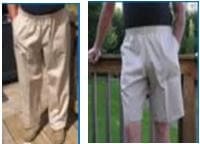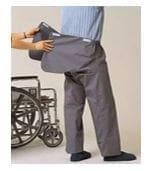- Clothing is a basic human need all over the world; it provides a sense of self-confidence and comfort, and the wearer feels physically, psychologically, and socially at ease.
- Uncomfortable clothing can take away the joy of living for particular groups, whose requirements are larger since they require more comfort and convenience to become independent than typical individuals.
- Special group, persons who depart from normal in terms of physical, mental, and social qualities to the point that they require special attire, education, and training. [1]
Adaptive Clothing

Different Types of Adaptive Clothing [4]
- Adaptive clothing is clothing created for persons who have difficulty dressing themselves due to age, disability, or a general lack of movement.
- Common misconceptions about adaptive clothing include the fact that it is only for people who are bound to a wheelchair. However, anyone who is limited by traditional clothing can benefit from adaptive clothing. This can include providing one-handed zippers on shoes, replacing buttons with magnetic closures, or designing clothing and footwear so you can get dressed while seated. [3]
Adaptive clothing is generalized by 2 main categories
- First are those with disabilities.
- The second group are those seeking rapid transformation.
Why Adaptive Clothing Is Required?
 Adaptive Clothing for wheelchair person [5]
Adaptive Clothing for wheelchair person [5]
Some Factors Contributing to Increased Access to Adaptive Clothing
- Adaptive clothing is intended to improve the wearer’s comfort.
- Button and tie navigation might be difficult for those with restricted movement or range of motion.
- Dressing fashionably might also increase acceptability.
- Can engage in more social activities. [4]
Qualities of Adaptive Clothing
- Adaptive Clothing feels and looks like regular clothing
- They must be designed both medically and stylishly
- They should be accessible in a wide variety of sizes. [5]
Features of Adaptive Clothing
- Makes self-dressing simpler by utilising special features like covert Velcro fasteners or snap closures that are less taxing on arthritic joints or for shaky hands.
- In contrast, fastenings like buttons or hooks could be difficult for a person to use if they have hand tremors or impaired vision.
- Adaptive clothing often has flat seams to decrease friction and subtle modifications to give a look that is as close to standard as feasible.
- Longer inseams on the rear of trousers, for instance, to provide a wheelchair-bound individual with additional covering. [6]
Types of adaptions
In order to make the clothing as comfortable as feasible for these people, further alterations are made. One is the capacity to breathe and the use of natural fibres to prevent skin irritation. Another is the use of specialised clothing designs, seams, and closures, such as those with outward-facing seams to prevent skin irritation or magnet-like closures that are simple to open and shut. Adaptive clothing often has flat seams to decrease friction and subtle modifications to give a look that is as close to standard as possible on the outside. For instance, longer inseams in the rear of trousers would provide a wheelchair-bound individual with additional covering. These modifications might include velcro and snap fasteners that are simple to use, fabric that stretches in either direction, space for incontinence aids in the clothing design, a longer rise in the back of the trousers to accommodate wheelchair users, and an elasticized waist for greater comfort and simpler dressing.
Some fastenings, including buttons and zippers, may be difficult for someone to operate if they have poor dexterity or none at all. As a result, velcro or magnetic fasteners are frequently used on adapted clothes instead of closures that call for greater dexterity.
Adaptive clothing may have hidden flap-openings or additional closures that enable the garment itself to be pulled on without having to bend over or reach up. This is because disabled people whose mobility prevents them from engaging in the typical full range of motion frequently struggle to put on clothing that must be pulled up from the feet or over the head. These might be velcro flaps at the neck and shoulders that, when the garment is dragged down over the head, cause the neckline to widen. The same modifications may be done for footwear and other accessories, with velcro fasteners being the most prevalent design element in adaptable footwear. [2]
Types of Adaptive Clothing

Different Types of Adaptive Clothing [6]
- Inner clothing should fit loosely for comfort and ease of wear

Adaptive Inner Wear [6]
- Clothes with the backs open reduce the need to rotate the arms or elevate the arms to put on a garment over the head.

Back Open Cloth [6]
- Pants for both men and women

Adaptive Trouser [6]
- Suspenders

Suspenders [6]
- The waistbands of skirts, pants and shorts can be made entirely without fasteners by using elastic.

Fastenings [6]
- Bladder control/ incontinence
- The seat of this back open duster is cutaway.

Adaptive Clothing [6]
- Pants for a person who is bound to a wheelchair

Adaptive clothing for wheelchair person [6]
Footwear The wearer should be as comfortable as possible in them, and it’s also crucial that they be easy to put on and take off.

Adaptive Shoes [6]
- Men’s shoes

Adaptive Shoes [6]
- House slippers (warm)
Adaptive Shoes
- People with edema, diabetes, sensitive skin, swollen feet and ankles, and sensitive corns and bunions might benefit from edema footwear

Adaptive Shoes [6]
- Diabetes elevates blood sugar levels, increasing the risk of foot ulcers
- Diabetic socks: manage moisture; lower infection risk.
- No seams or material that wrinkles easily; lessens pressure and scorching
- Non-binding top; blood flow is improved and constriction is reduced.

Adaptive Socks [6]
- Thermal socks: these tight-fitting, warm, absorbent materials, such wool, help to retain heat, which helps to regulate core body temperature.
- Slip-resistant socks to avoid mishaps. [6]

Adaptive Socks [6]
Adaptive Clothing for Toddlers

Plate No. 23 Adaptive Clothing for Toddlers (11)
Self help
The features that help the child to put on and take off the garments easily on their own are called ‘self-help’ features. These features develop independence in the child and foster a feeling of confidence and self-reliance. (7)
Adaptive Clothing for Toddlers

Adaptive Clothing for Toddlers [7]
Self-help features
Self-help features are those that make it simple for a youngster to put on and take off clothing on their own. These characteristics help the youngster become independent and promote self-assurance and self-reliance.
Following are some of the self-help features that can be incorporated into the preschool child’s clothing:
- Big openings in clothing make dressing simpler.
- Compared to rear or side entrances, front openings are simpler to manage.
- Without assistance from an adult, a kid may effortlessly grip big buttons and dress itself.
- In order for a youngster to quickly identify a piece of clothing, the front must differ from the rear.
- Handling simple styles is simpler than handling complex ones.
- Large armholes and neck openings, together with long sleeves, make clothing easy to put on.
- One-piece clothing is simpler to put on than two-piece clothing.
- It’s easier to put on mittens than gloves.
- Collarless dresses are simpler to handle than those with elaborate design details.
- Separate belts should be avoided since they might become tangled or trapped in clothing. [8]
Brands offer Adaptive Clothing

Brand Logo [3]
Few brands that offer adaptive clothing:
- Tommy Hilfiger
- Land’s End
- Target (Target also has some adult adaptive clothing)
- Zappos clothing and shoes
- Kohl’s [3]
Web Rreferences
- linda-karimi Follow. (n.d.). Clothing for special groups. Share and Discover Knowledge on SlideShare. Retrieved February 27, 2023, from https://www.slideshare.net/linda-karimi/clothing-for-special-groups
- Wikimedia Foundation. (2023, February 12). Adaptive Clothing. Wikipedia. Retrieved February 27, 2023, from https://en.wikipedia.org/wiki/Adaptive_clothing
- 4 reasons adaptive clothing and shoes are important. Fraser. (n.d.). Retrieved March 1, 2023, from https://www.fraser.org/resources/blog/4-reasons-adaptive-clothing-and-shoes-are important#: ~:text=More%20comfortable%20to%20wear, sensitivities%20may%20have%20texture%20sensitivity.
- Adaptive Clothing: Home care dressing made easier. Private Home Care Service – Ezra Home Care Newton. (n.d.). Retrieved February 27, 2023, from https://www.ezrahomecare.com/home-care-blog/adaptive-clothing-home-care-dressing-made-easier
- Pittman, T. (2018, August 31). 7 companies making fashion more inclusive for kids with disabilities. HuffPost. Retrieved March 1, 2023, from https://www.huffpost.com/entry/adaptive-clothing-inclusive-fashion_n_5b841548e4b0cd327dfea255
- linda-karimi Follow. (n.d.). Clothing for special groups. Share and Discover Knowledge on SlideShare. Retrieved February 27, 2023, from https://www.slideshare.net/linda-karimi/clothing-for-special-groups
- Teaching your child how to get dressed. Raising Children Network. (2022, May 6). Retrieved March 1, 2023, from https://raisingchildren.net.au/toddlers/health-daily-care/dressing/how-to-get-dressed
- Fundamentals of clothing construction 3(1+2). FCC: Self-help. (n.d.). Retrieved March 1, 2023, from http://ecoursesonline.iasri.res.in/mod/page/view.php?id=27375

